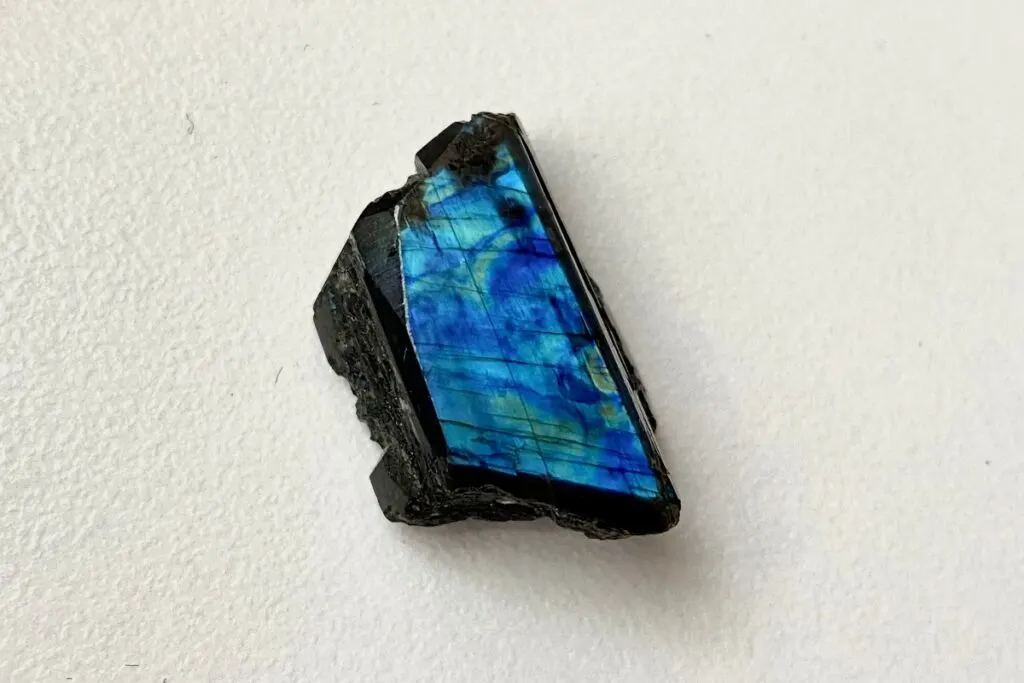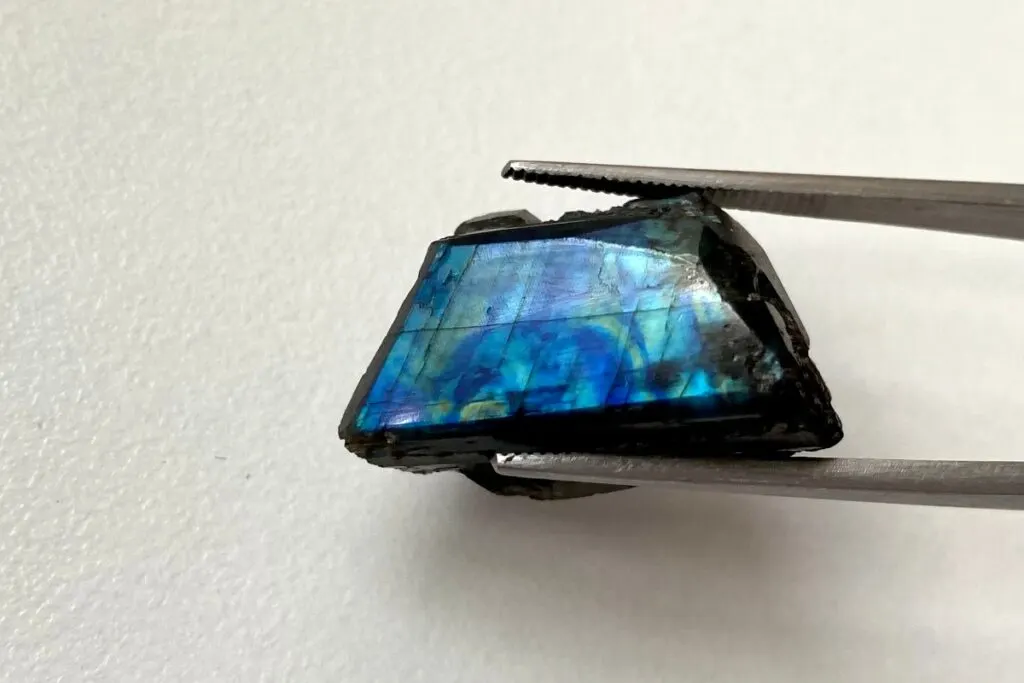As an Amazon Associate, I earn from qualifying purchases with no additional costs for you.
Labradorite is incredibly valuable for its iridescence phenomenon, usually compared to peacock tale or Aurora light. Not all labradorites have this optical effect, so the gemstone price strongly depends on that. Some other factors influence labradorite price. The stone is commonly not expensive, but for a small amount of money, you will receive a firework of Aurora light on your finger or as your interior decoration.
Labradorite value factors are the play of color, the range of iridescence colors, the background color, the pattern, and craftsmanship. The most important is a play of color. The more intense the color shifting, the more valuable the stone is. Common labradorite cabochon can be purchased for $10-50.
The most significant advantage of labradorite is that it can be used in an extensive range of jewelry, from several carats only to interior design, with the slabs weighing up to 100 kilograms. Labradorite is readily available. It makes up rock plutons! That is why labradorite is available in many qualities, from transparent gemstones to opaque black rocks. Further, we will speak about the value factors of diverse labradorites.

If you are interested in checking out the best books about rock and minerals identification you can find them by clicking here (Amazon link).
Is Labradorite Worth Anything
Labradorite, (Ca,Na)(Al,Si)4O8, is a variety of plagioclase feldspar, intermediate between albite (Na-rich end member) and anorthite (Ca-rich end member). Labradorite occurs in mafic igneous rocks, most commonly in basalt and gabbro. The uncommon anorthosite bodies are composed almost entirely of labradorite.
Labradorite in the form of cabochons is the most common variant of this gemstone you can be offered. Several centimeters of cabochons are worth from $5 to 50 per piece. Carved labradorite commands higher prices. They are strongly dependent on craftsmanship and price range up to several hundred. The most pricey are faceted stones.
Labradorite belongs to a feldspar group of minerals. Feldspars are the most widespread minerals in the earth’s crust and some of the most diverse. The closest related gemstones to the labradorite, which belong to the same group, are moonstones and sunstones.
Typical labradorite looks like a dark-colored gray, brown, or black translucent mineral with distinct cleavage planes and blue to green play of color effect. It’s important to mention that not all labradorites have iridescence, and not all minerals with the play of color are labradorite.
Iridescence phenomenon can be observed in other plagioclase feldspars like andesine and bytownite. However, chemical analysis to determine the concentration of Na and Ca needs to be done to tell plagioclase feldspar members one from another.
Famous Oregon sunstone is mineralogically labradorite. Oregon sunstone rarely has a distinct play of color effect; however pure native copper inclusions cause the aventurescence effect.
Oregon sunstone occurs in different light yellow, orange, and red colors and transparent crystals suitable for faceting. Faceted Oregon sunstones of high quality are highly valuable.
How Much Is Labradorite Worth
Labradorite cut en cabochon of various outlines (round, pear, ovals) are worth $5-50 depending on the intensity of play-of-color and size. Carved specimens of cabinet size cost up to $500-600, depending on craftsmanship. Faceted stones of gem quality command prices up to $100 per carat.
The most valuable labradorite variety is Oregon sunstone. It is rarely called labradorite, but mineralogically this is made of labradorite mineral. The price for bi-colored orange and green or bloody-red faceted transparent Oregon sunstone reaches $500 per carat.
BTW: Do you want to know more about rock and mineral identification? The books listed below are the best ones you can find on the internet (Amazon links):
- Smithsonian Handbooks: Rocks & Minerals
- Gemstone & Crystal Properties (Quick Study Home)
- Ultimate Explorer Field Guide: Rocks and Minerals (National Geographic Kids)
Why is Labradorite So Expensive? Main Factors
Labradorite is an affordable gemstone; however, some extraordinary varieties, like spectrolite and Oregon sunstone, can command the highest prices. The main factor is a play of color effect, but some additional details will surprise you.
There are five value factors of labradorite. The main factor is the presence of iridescence or play of color. The following factors are the colors of iridescence, the pattern they occur in, the background color that contrasts the iridescence, and craftsmanship.
Play of color (iridescence)
The primary and most magnificent factor of labradorite value is iridescence or play of color. It is often called more poetically Aurora lights, Northern lights, Borealis, butterfly’s wings, peacock tail, or just a rainbow effect.
Labradorite is a plagioclase feldspar. It forms fine, microscopic, intergrown layers of albite and other plagioclase feldspars. The mesmerizing optical phenomenon originates when a beam of light hits the mineral.
The light waves interfere with each different microscopic mineral layer, creating bands of shimmering spectral color, typically blues and greens. This phenomenon is called labradorescence, named after the mineral that displays it.
The color of iridescence
Standard labradorescence colors are blue and green. However, sometimes the sone can display the full spectrum of colors resembling a complete rainbow. These stones are called spectrolites.
Red and orange colors of labradorescence are far rarer and, therefore, highly valuable. In addition, color combinations can sometimes create gentle pink or gold hues, increasing the stone’s value.
The pattern
The pattern of the iridescence occurring in a stone is also considered while deciding on the labradorite’s value. Evenly distributed colors are more valuable than irregular unpredictable flashes.
The background color
The background color of the labradorite is commonly omitted, but it can significantly influence the appearance of the stone. Labradorite from different localities has different bodycolor.
For example, the brown body colors of the labradorite from Angola inhibit the play of color, and the stone looks pale and not so appealing.
The light gray background color of translucent larvikite from Norway prevents the outburst of spectral colors. The most suitable background color to emphasize the play of color is black. Labradorites from Ukraine, Canada, and Madagaskar have the best contrast.
Craftsmanship
The essential value factor is craftsmanship. While cutting or carving a labradorite, the person should know how to orient the stone the way to retain the best play of color effect.
This is strongly dependent on crystal structure, so the cutter should be highly skilled to bring out the optical phenomenon in the best possible way.
The most valuable samples of labradorite should have correctly placed play of color on the stone surface. The most valuable is a face-up position when you look at the center of the piece and see the colorful light flashes. Worse variants are when you need to rotate the stone to activate a play of color. These pieces are less valuable.
TIP: Some minerals can be easily identified at a first glance because of their unique properties, but others require state-of-the-art appliances. Check out the complete guide on mineral identification in the article below:
Easy Step-by-Step Mineral Identification (Expert Explains)
Labradorite Price per Pound, Kg, Gram & Carat

Labradorite prices do not exceed a thousand dollars pricetag. Commonly labradorite is sold in the form of cabochons, and they are worth $5-10 per piece. Rough material is sold mainly per pound or kilo and can be purchased for $70-100. Carved cabinet specimens of several kilos cost up to $500.
The table below is designed to understand the prices for different units. The price per pound in bold is the most common for common dark-colored labradorite with a blue play of color. Prices per carat and gram are also indicated for transparent faceted labradorite gemstones (mainly Oregon sunstones).
| Units | Labradorite price |
|---|---|
| per carat | $2 per carat for cabochon. $80-70 for a faceted gemstone. Up to $500 for Oregon sunstone. |
| per gram | $7-10 per cabochon. $250-500 for a faceted stone |
| per ounce | $20-30 |
| per pound | $60-100 |
| per kilo | $150-220 |
TIP: Real labradorite has such a unique play-of-color phenomenon that can be hardly copied in fake labradorites. Find out more about fake labradorites in the article below:
Real vs. Fake Labradorite: Focus on These 8 Differences
Where to Buy Labradorite
Labradorite is a readily available material, so it is safe to buy it everywhere. You can feel secure even while shopping on online platforms. High-quality genuine material is available at every local mineral show. The only warning is a small number of plastic fakes are rarely present.
Labradorite is present all over the globe in massive thousand square kilometers amounts. For North America, a significant supplier is Canada, where labradorite was initially found and described scientifically.
In addition, Norwegian, Finland, and high-quality Ukrainian labradorite can cover the European market. Other sources of labradorite are Angola and Madagascar. Madagascar is the world’s biggest supplier of top-quality labradorite and its spectrolite variety.
Conclusion
Labradorite is a valuable gemstone because of its captivating play of color effect. The better, the brighter, and the bigger the flashes of color are, the more valuable the stone is. We can distinguish five main value factors of labradorite:
- The presence of play of color or labradorescence effect.
- The range of colors. Spectrolite – a variety that displays a rainbow of colors at once is the most valuable. Red, orange, pink, purple, and yellow colors are rare and highly praised.
- The pattern. The flashes of color should be evenly distributed and located near the center of the stone.
- The background color. Darker and more saturated body colors of labradorite create a contrasting background to play of color effect.
- Craftsmanship. Because of the complexity of the play of color origin, a craftsman has to orient the crystal correctly to bring out the flashes. Correct, nicely cut, and carved specimens are the most valuable.
TIP: You need to know which rocks shine the best and the tools and materials you can use to polish them. Check out the guide on cleaning your rocks without a rock tumbler in the article below:
How To Clean Rocks Without A Tumbler? Make Your Rocks Shiny!
